White Bordeaux: 2014 vintage

With a focus on Château Smith Haut Lafitte
By Panos Kakaviatos for wine-chronicles.com
15 September 2020
Top three 2014 whites from this tasting? Domaine de Chevalier, Château Pape Clément and Château Smith Haut Lafitte
Last week Decanter Magazine published an article I wrote – subscribers only – about how fine dry white Bordeaux can be, with a focus on the Pessac-Léognan appellation. For that text, I tasted wines from the 2014 and 2015 vintages, as they show some age and because they are so different. Tasting notes in the article focused on 2015 for two reasons: (1) given global climate change, a warmer vintage like 2015 will become more common and (2) it seemed by and large more ready to drink in 2020. For either vintage, one best enjoys quality dry whites not immediately upon release, but at least with five years aging.
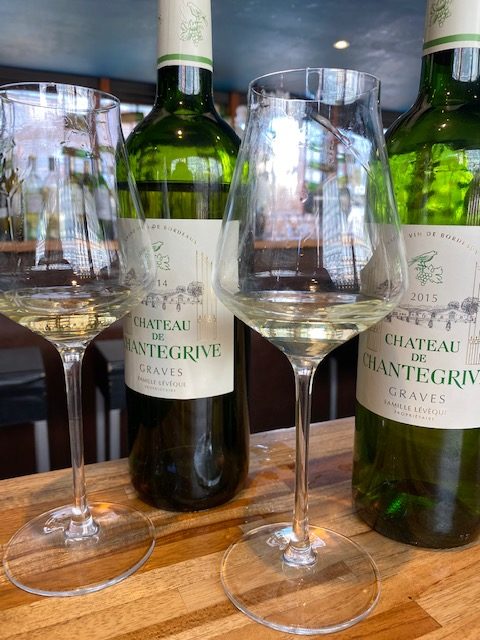
Note how Château de Chantegrive (Graves AOC) in 2014 looks more evolved than the 2015, by more than just one year. It was not the only example. Two very different vintages, but interesting tasting results.
Worthy mention on how more humble wines from the Graves region – not just from the more elite Pessac-Léognan – did very well in the tasting I did for the article. Take for example Château de Chantegrive 2015. I served a bottle for friends who regularly drink fine wine, and they were happy: “A five-year-old white Bordeaux?” one almost exclaimed in posing the question. Yes it is, I affirmed. And it costs under $20 a bottle.
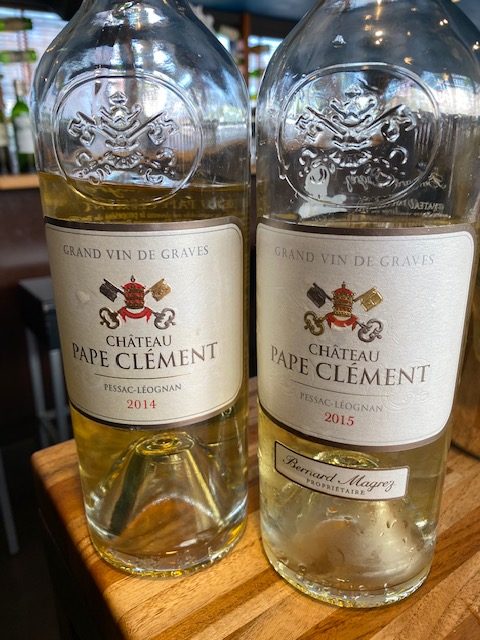
In the case of Château Pape Clément, the 2014 knocks the socks off of the 2015. 😊
When I visited Domaine de Chevalier earlier this summer, owner Olivier Bernard had me taste other properties he sells that are Bordeaux AOC appellations and these, too, are fine dry whites. By the same token, I was invited to judge a series of Bordeaux AOC wines for the “Oscars of Bordeaux” and several did very well, as you can read here.
Given space considerations, I did not include formal tasting notes from the 2014 vintage, although referred to that year often in the text. In these pages, however, you get the 2014 tasting notes. It is important to take note of how all estates covered in the article have improved precision in winemaking and viticulture in recent years. Others, such as Domaine de Chevalier, have been long known for their high quality dry white wines (but never sitting on its laurels). Others are in the midst of change. You can read for example in Decanter about how well Château Malartic Lagravière has upped its game in recent years. And much can be said of improvements to come at Château La Louvière, which will be the subject of a future text in wine-chronicles.com, based on my visit there earlier this summer.
Before you go to the tasting notes, here a focus on one estate that serves as a particularly great example of why white Bordeaux has become so interesting in recent years: Château Smith Haut Lafitte, as it is making some of the very best Bordeaux whites today.

Château Smith Haut Lafitte
Château Smith Haut Lafitte
Much has been said of the great work by the dynamic couple Florence and Daniel Cathiard to energize this estate since their purchase back in 1990: from rebuilding the cellars and making their own barrels since 1995, to innovative recycling that captures CO2 during fermentation and producing their own rootstocks on a private island in the Garonne.
Vineyard area covers 67 hectares, of which 56 are planted with grape varieties of 55% Cabernet Sauvignon, 35% Merlot and 10% Cabernet Franc. The remaining 11 are cultivated with 90% Sauvignon blanc, 5% Semillon and 5% Sauvignon Gris.
A more recent achievement last year was realized when the estate earned its “Agriculture Biologique” (organic agriculture) certification. Since 2018, half of its vineyards have been treated biodynamically.
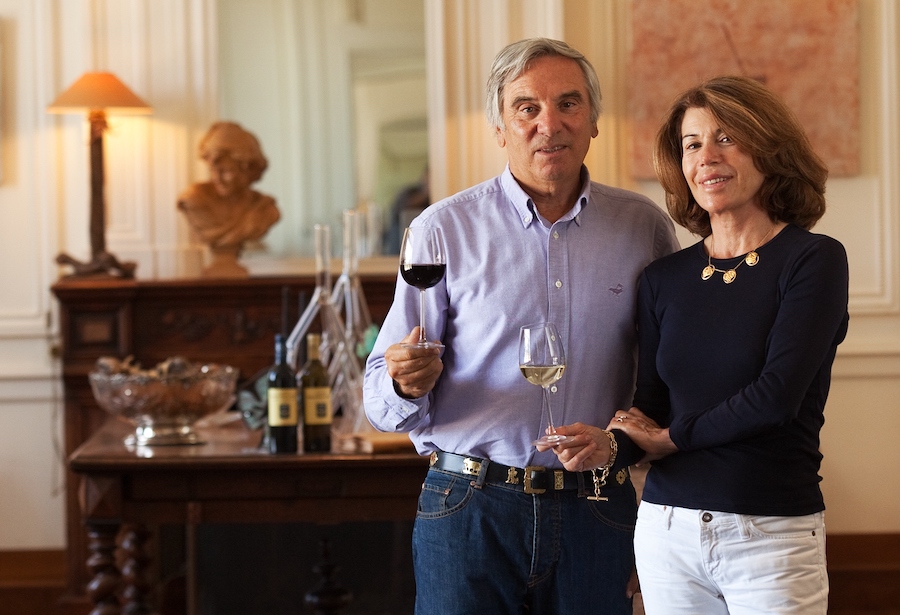
Daniel and Florence Cathiard of Château Smith Haut Lafitte (photo courtesy of the estate)
It is worth noting that the château wasn’t making white wine at the time of the 1950s-era classification for the reds and whites of the Graves region. And yet, even before the Cathiards arrived at the scene, Château Smith Haut Lafitte was crafting good dry whites. Back in 2018, for example, the Cathiards invited me to a special vertical tasting of vintages ending in -8, and the 1988 white proved very tasty.
Massale Selection
Since 1990, the quality of Smith Haut Lafitte whites (and reds) has steadily increased. Partly at least thanks to a study made over an 18-month period to map the terroir in great detail and adopt wine growing accordingly. To keep a close eye on ripening, the estate is assisted with a satellite system enabling a detailed view on each vine row.
But before the (manual) harvest already, the Cathiards had set up a massale selection for grapes, based on a conservatory of genetic diversity. As general director Fabien Teitgen explains: “We selected from our old white vines that have grapes of great quality potential. After confirming good health (absence of virus), we created a conservatory with the goal to keep the characteristics of Smith Haut Lafitte white, having the same genetics as the original vines. We wish to preserve the genetic heritage guaranteeing specificity and originality. Genetic conservation provides a memory and imprint of property.”
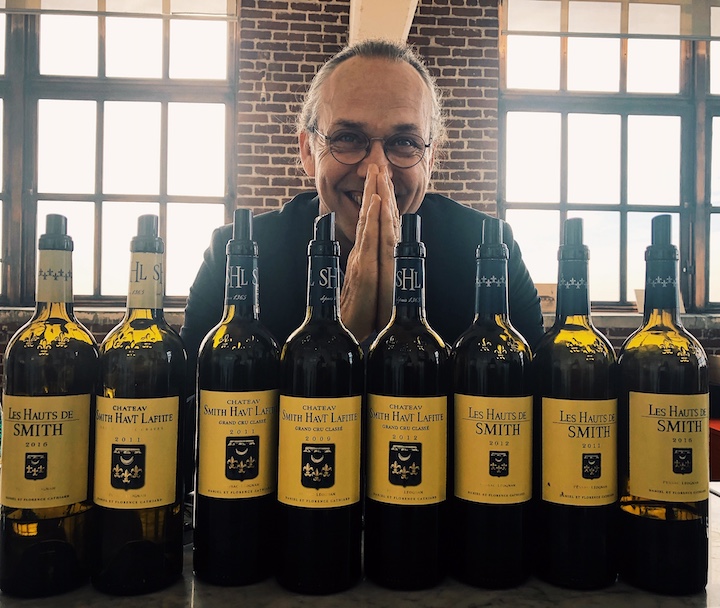
The ever genial and professional Fabien Teitgen, general director at Château Smith Haut Lafitte (photo courtesy of the estate)
Light, shade and horses
The devil is in the details, and the estate spares none. Even for the impact of light. The proper use of shade and light for grape bunches is thus carefully anticipated. “Balance for white wine is essential,” Teitgen says. The estate seeks “real maturity” for the grapes: “To do this, we do not directly expose bunches to light, but obtain ventilation by removing the inter-cores (small offshoots of the twigs) while retaining the leaves. The bunches are then well ventilated – between shade and light – without direct exposure to fully ripen. Thus risks of grape burning and lack of acidity minimized. This is important as vintages get warmer.
You may have heard of the famous horses used for plowing vineyards at Château Pontet Canet in Pauillac, but this is done at Smith Haut Lafitte, too. White grape vines are planted on their ‘Côteau des Blancs’, which is composed of gravel-clay soils. These soils have a good water reserve, which is important in a time of increasing concerns over droughts; indeed, water springs along the mid-slope prove favorable for the white grapes. However, because these soils are very fragile and very sensitive to compaction, the estate has replaced tractors with horses for plowing and weeding, Teitgen explains.
Careful harvesting
The 100+ crew of harvesters work via intra-plots and successive sorting. Château Smith Haut Lafitte is fortunate to have old plots, which come from massale selections so vines are different and bunch maturity is non-simultaneous, with some ripening earlier than others. To gather grapes of homogeneous maturity, Teitgen explains: “We must collect as they mature, passing two, three times in each plot to collect these ripe grapes”. The key is the color of the berries, he adds, as harvesters pick up yellow clusters while letting green clusters ripen more. He says that there is a meticulous aspect to tasting the grapes, before fulling harvesting: “It’s a drastic selection to seek maturity, perfect balance and ideal taste”.
Winemaking innovation
Using an insert press has proven essential for quality, Teitgen stresses: “It’s about finding balance between efficient pressing to extract juices and gentle pressing to avoid crushing and bad stalk tastes”, he explains. “We use inert pneumatic horizontal presses whereby everything takes place under nitrogen. There is therefore no oxidation (loss of aromas and degradation of color) during pressing, so we can press for a very long time (3 to 4 hours) and very gently. That way, we can get the full potential of our grapes, while maintaining clear, clean, crystalline, pure and very precise juices.”
Château Smith Haut Lafitte ferments the must in Bordeaux château barrels, made at the château’s own cooperage: yet another detail covered by the estate itself. Fermentation is carried out gently as the supply of oxygen through the barrels promotes fermentation and limits the risks of reduction. Controlling cellar temperature guarantees moderate fermentation temperatures to preserve aromas and balance, Teitgen explains. He likes to use a phrase that more and more winemakers employ: “We are getting back to basics, the grape: The less you touch the grape, the less you touch its purity, and the greater the wine.”
Careful to avoid premature oxidation, the 10-12 month aging following fermentation on total lees does not include racking. Indeed, “lees stirring is no longer used regularly and is only used to manage oxygen balances,” he says. So aging is very gentle thanks to barrel micro-oxidation.
I have come to appreciate very much the high quality of the dry whites of Smith Haut Lafitte more and more over the years, and all this hard work and precision has borne both its fruit and … grand vin!
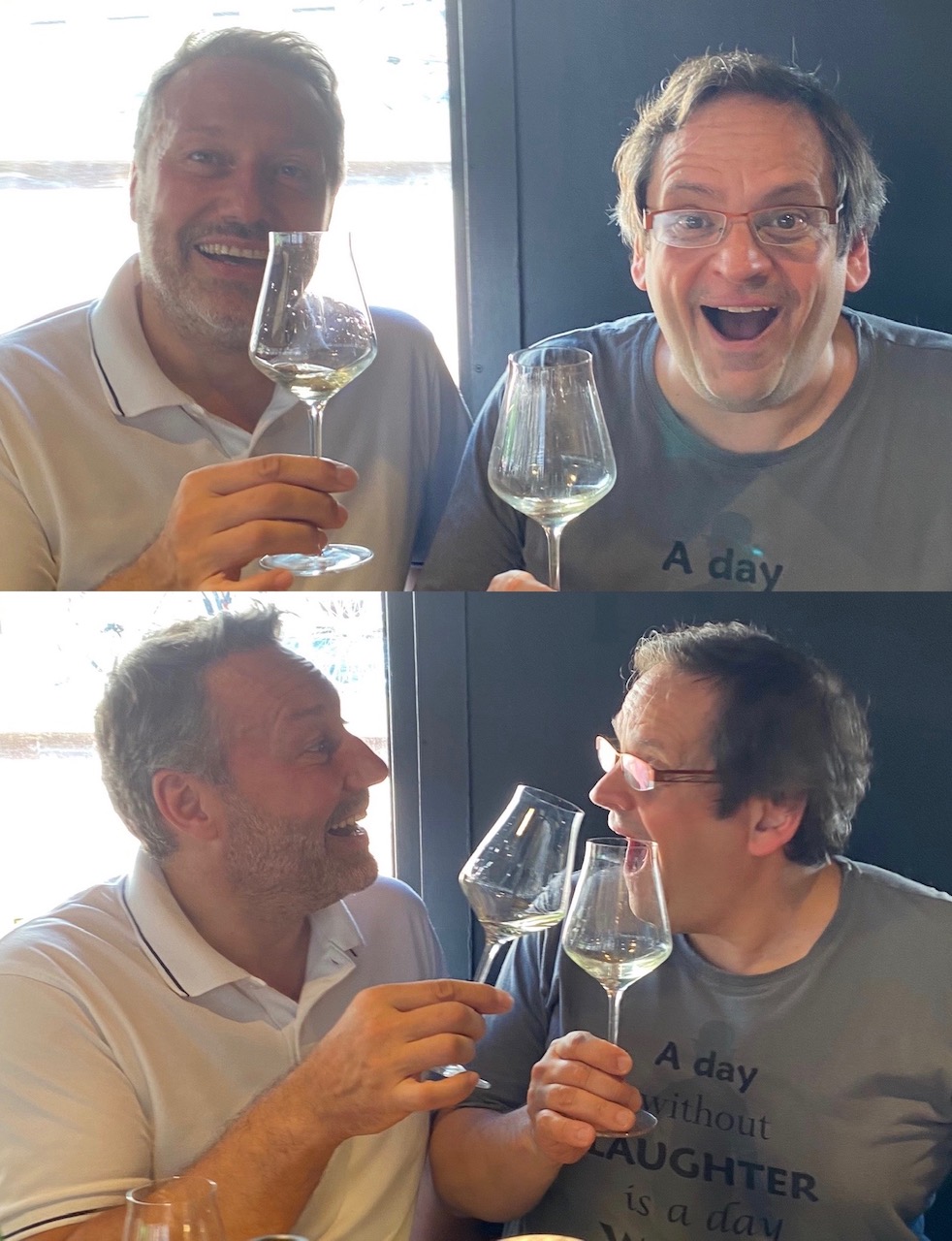
How you can react after tasting excellent white wines of Graves and Pessac-Léognan: with Stéphan Maure of Ill Vino in Strasbourg
About 2014
The 2014 vintage can be great for dry white Bordeaux. Indeed, the vintage for dry whites is darn good throughout France: it is great in Burgundy and Alsace, as well, for example. Based on the barrel samples as reported by yours truly for Total Wine to tasting from bottle in New York City in January 2017, Bordeaux dry whites proved promising. And while that promise was again fulfilled for this wine-chronicles.com feature, the wines were not so consistent throughout.
Indeed, I tasted the 2015 vintage alongside the 2014. Some 2015 counterparts show better today.
Perhaps the more “classic linearity” of the 2014s needs more time?
While tasted with French sommeliers in Strasbourg earlier this summer, we agreed that opulence may not be a 2014 hallmark, but precision certainly is. In some cases, such as with Château La Louvière, it may have been a question of bottle enclosures, as the estate introduced the Diam cork from the 2015 vintage, which looked and tasted younger – and by more than just one year.
In other cases, stylistic differences and terroir sites made the difference. For example, the warmer Pessac vineyards of Château Pape Clément shined brighter in the relatively cool 2014 vintage than they did in the warmer 2015 vintage.
In any case, tasting notes show some gems from 2014: As usual, wines in bold, I liked in particular. When red and bold, even more. And if underlined, too, a kind of wine nirvana.
GRAVES AND PESSAC-LEOGNAN 2014 VINTAGE TASTING NOTES
Château de Chantegrive AOC Graves Blanc – Blending equal parts of Semillon and Sauvignon Blanc, it was interesting how this vintage seemed more evidently evolved as compared to its 2015 counterpart, which had even showed some reduction. By contrast, the 2014 was ready to go from the get go. We all described it as “quite open and fun” to drink with white stone fruit and lemon pie aspects. And yet, the palate was displaying some caramel and toffee, too. 13% alcohol. I preferred the 2015 although could it have been just the bottle of the 2014? 90
Château Clos Floridène AOC Graves Blanc – Pleasing linden and herb aromas, neither green nor varietal, but elegant and refined. Although the palate gets more varietal with tell tale gooseberry from the (55%) Sauvignon Blanc, it conveys nuance and elegance. Indeed, the 2014 is superior to the 2015 vintage because it has greater refinement and subtlety in expression. An ideal choice for your oysters on a half shell (Hey, the months now have “r” again in the spelling so go for it!). 12.5% alcohol 91
Château Bouscaut AOC Pessac-Léognan Blanc – It is a pity that this particular bottle was showing off rancio aspects and came across far too evolved. The color is noticeably more aged than the 2015 counterpart! And not just by one year… While this could be enjoyed with truffle pasta, I would think another bottle would be in order. In any case, the 2015 is superior, but it could be just a question of this particular bottle. Note reserved.
Château Carbonnieux AOC Pessac-Léognan Blanc – An excellent vintage : combine the relatively warmer terroir as compared to, say, La Louvière and the cooler vintage and you get a good match. The slow ripening yields both focus and elegance, with iodine seashell, lemongrass and grapefruit with a touch of acacia. The blend of 75% Sauvignon Blanc and 25% Semillon reminds me again why this wine can be so popular. And even though prices are edging up, the price/quality ratio remains excellent. OK, the medium plus length does not match the “big guns” of Pessac-Léognan, but what a pleasure to drink! Here the 2015 loses to the refined focus of the 2014. 13% alcohol. 93
Château Couhins-Lurton AOC Pessac-Léognan Blanc – At 13% alcohol, this 100% Sauvignon Blanc comes across more streamlined and fresher when compared to the 2015 vintage, which is 14%. A lovely nose of wet stone, lemon grass and chamomile. Not super long on the finish, but both pretty and smooth, its nuanced mid palate impresses with elegance. “Very well done,” remarked Stéphan Maure, owner of the wine bar Ill Vino in Strasbourg, where I tasted the wine. Indeed, I think that the Couhins-Lurton could be a better wine than the 2015 vintage in terms of precision and focus but both are darn good. 93
Château de France AOC Pessac-Léognan Blanc – Another wine that fits the notion of 2014 being “superior” to 2015. I like its grip as being more “serious” than the 2015, and it has greater freshness on the finish. The blend is 80% Sauvignon Blanc and the rest Semillon, having aged in 40% news barrels with lees stirring once a week that lent a bit of creaminess to the otherwise fresh and even crisp palate. I liked the long and refreshing finish: a wine well worth seeking out for its excellent price/quality ratio. 13% alcohol 93
Château La Louvière AOC Pessac-Léognan Blanc – As much as I loved the 2015, the 2014 looks more evolved that its younger brother and not by just one year. According to owner Jacques Lurton, it is about enclosures as the estate went to Diam as of 2015 to ensure freshness. In and of itself, this is pretty good. Indeed, when tasted again at the estate, there is acacia, honeysuckle and almost lilac notes. Some balsamic aspects. 13% alcohol. Does not reach the heights of the excellent 2014 whites from other estates. 90
Château Larrivet Haut-Brion AOC Pessac-Léognan Blanc – Here the 2014 vintage is more similar than different compared to the 2015. It has one half a degree less alcohol, at 13.5 as opposed to 14, but again conveys aromatic charm, both subtle and refined, with lemon meringue sumptuousness. It does have a bit more verve on the palate, which remains soft and smooth. It blends 80% Sauvignon Blanc and 20% Sémillon and had been aged in 50% new oak, 30% small oak casks and 20% concrete eggs. 91
Château Latour-Martillac AOC Pessac-Léognan Blanc – Alas, the bottle was corked.
Château Malartic-Lagravière AOC Pessac-Léognan Blanc – It was great to compare with the 2015 – featured in my Decanter text. This vintage, the 2014, also clocks in at 14% alcohol. While the 2015 seems riper and more complete on the palate for now, the advantage for this vintage, blending 90% Sauvignon Blanc and 10% Semillon, is its gorgeous linearity, bright tension and precision leading to a long finish. Yes, you get a characteristic creamy texture, but not as evident as in 2015. I think the 2014 will be a superior wine time, given more noticeable tension/energy. Aged for 12 months on the lees with lees stirring and in French oak, of which 60% was new oak. An excellent example of superb white Bordeaux at a fair price! 94+
Château Olivier AOC Pessac-Léognan Blanc – Alas, the bottle was corked.
And the top three … drum roll!
Domaine de Chevalier AOC Pessac-Léognan Blanc – With a bit more Sauvignon Blanc in the blend than its 2015 counterpart (the blend here is 75% Sauvignon Blanc and 30% Semillon), the 2014 lacks the more exotic aspects of the 2015, which blends 70% Sauvignon Blanc and the rest Semillon. It is interesting how the tone of the 2014 is a touch darker in color, but still straw or pale lemon. Owner Olivier Bernard stresses how, since 2015, he corks his bottles with Diam30 to ensure greater freshness. Nonetheless, the 2014 conveys much elegance and bright fruit expression as well as beguiling white flower. Over time, sweet herb aromas come to the fore. Long and cool finish. While highly rated, this particular bottle seems slightly over evolved, as I have had better examples of this vintage with higher scoring bottles. 95
Château Pape Clément AOC Pessac-Léognan Blanc – What a difference compared to the 2015, which to me came across a bit too heavy handed. The alcohol clocks in at 14%, but the balance here is very successful as you get pear liqueur, white apricot and – sure – “decadent juiciness” as one could expect from this producer, but you also get streamlined, refined and elegant expressions with all that: certainly more than the 2015. Indeed, a top wine of this tasting, as it has turned out better than in earlier tastings. Bravo! 95
Château Smith Haut Lafitte AOC Pessac-Léognan Blanc – One cannot but admire the refined and linear elegance of this vintage and this estate does not disappoint, conveying fine lime and lemon brightness and focus throughout. While the 2015 shows off riper quince and generally riper white stone fruit – a rounder expression – the 2014 plays it “closer to the vest”, and I wonder if we should have poured into a carafe and waited another three hours. Still, a very impressive showing, so bravo to the Cathiards and their team. Give it time… 13.5% alcohol. 95
Strength in Unity
One final note to stress: Most all owners of vineyards in Pessac-Léognan and the Graves region in general, from Château Haut Brion to Clos Floridène, show impressive solidarity. Graves and Pessac-Léognan winemakers often organize special events – to commemorate the harvest, to celebrate the Christmas season – and always act like a team, even if they can be competitors. It is thus a joy to visit the Graves region in part because of this sense of solidarity among winemakers and vineyards. “Bravo” to the Graves region, whether white or red! But do try the whites, because they are often overlooked! 😊
 Wine Chronicles
Wine Chronicles
Share This